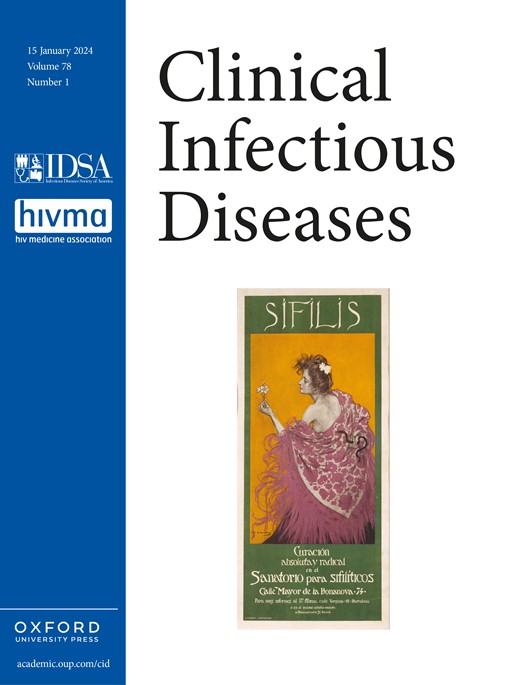Clinical- and Cost-Effectiveness of Liver Disease Staging in Hepatitis C Virus Infection: A Microsimulation Study
IF 8.2
1区 医学
Q1 IMMUNOLOGY
引用次数: 0
Abstract
Background Liver disease assessment is a key aspect of chronic hepatitis C virus (HCV) infection pre-treatment evaluation but guidelines differ on the optimal testing modality given trade-offs in availability and accuracy. We compared clinical outcomes and cost-effectiveness of common fibrosis staging strategies. Methods We simulated adults with chronic HCV receiving care at US health centers through a lifetime microsimulation across five strategies: (1) no staging or treatment (comparator), (2) indirect serum biomarker testing (Fibrosis-4 index [FIB-4]) only, (3) transient elastography (TE) only, (4) staged approach: FIB-4 for all, TE only for intermediate FIB-4 scores (1.45–3.25), and (5) both tests for all. Outcomes included infections cured, cirrhosis cases, liver-related deaths, costs, quality-adjusted life years (QALYs), and incremental cost-effectiveness ratios (ICERs). We used literature-informed loss to follow-up (LTFU) rates and 2021 Medicaid perspective and costs. Results FIB-4 alone generated the best clinical outcomes: 87.7% cured, 8.7% developed cirrhosis, and 4.6% had liver-related deaths. TE strategies cured 58.5%–76.6%, 16.8%–29.4% developed cirrhosis, and 11.6%–22.6% had liver-related deaths. All TE strategies yielded worse clinical outcomes at higher costs per QALY than FIB-4 only, which had an ICER of $12 869 per QALY gained compared with no staging or treatment. LTFU drove these findings: TE strategies were only cost-effective with no LTFU. In a point-of-care HCV test-and-treat scenario, treatment without any staging was most clinically and cost-effective. Conclusions FIB-4 staging alone resulted in optimal clinical outcomes and was cost-effective. Treatment for chronic HCV should not be delayed while awaiting fibrosis staging with TE.丙型肝炎病毒感染者肝病分期的临床和成本效益:微观模拟研究
背景 肝脏疾病评估是慢性丙型肝炎病毒(HCV)感染治疗前评估的一个重要方面,但考虑到可用性和准确性的权衡,关于最佳检测方式的指南存在分歧。我们比较了常见纤维化分期策略的临床结果和成本效益。方法 我们通过终生微观模拟,对在美国医疗中心接受治疗的慢性丙型肝炎病毒感染成人进行了五种策略的模拟:(1) 不进行分期或治疗(比较者);(2) 仅进行间接血清生物标志物检测(纤维化-4 指数 [FIB-4]);(3) 仅进行瞬态弹性成像 (TE);(4) 采用分期方法:(4)分阶段方法:对所有患者进行 FIB-4 检测,仅对 FIB-4 中级评分(1.45-3.25)患者进行 TE 检测;(5)对所有患者进行两种检测。结果包括治愈的感染、肝硬化病例、肝脏相关死亡、成本、质量调整生命年 (QALY) 和增量成本效益比 (ICER)。我们采用了文献资料显示的失访率(LTFU)和 2021 年医疗补助的视角和成本。结果 单用 FIB-4 可获得最佳临床疗效:87.7%的患者治愈,8.7%的患者发展为肝硬化,4.6%的患者死于肝脏相关疾病。TE 策略治愈率为 58.5%-76.6%,16.8%-29.4% 的患者发展为肝硬化,11.6%-22.6% 的患者死于肝脏相关疾病。与不进行分期或治疗相比,仅使用 FIB-4 的 ICER 为 12 869 美元/QALY,而使用 TE 的 ICER 为 12 869 美元/QALY。LTFU推动了这些研究结果:只有在无LTFU的情况下,TE策略才具有成本效益。在护理点 HCV 检测和治疗方案中,不进行任何分期的治疗最具临床和成本效益。结论 仅进行 FIB-4 分期即可获得最佳临床效果,且具有成本效益。在等待使用 TE 进行纤维化分期时,不应延迟慢性 HCV 的治疗。
本文章由计算机程序翻译,如有差异,请以英文原文为准。
求助全文
约1分钟内获得全文
求助全文
来源期刊

Clinical Infectious Diseases
医学-传染病学
CiteScore
25.00
自引率
2.50%
发文量
900
审稿时长
3 months
期刊介绍:
Clinical Infectious Diseases (CID) is dedicated to publishing original research, reviews, guidelines, and perspectives with the potential to reshape clinical practice, providing clinicians with valuable insights for patient care. CID comprehensively addresses the clinical presentation, diagnosis, treatment, and prevention of a wide spectrum of infectious diseases. The journal places a high priority on the assessment of current and innovative treatments, microbiology, immunology, and policies, ensuring relevance to patient care in its commitment to advancing the field of infectious diseases.
 求助内容:
求助内容: 应助结果提醒方式:
应助结果提醒方式:


